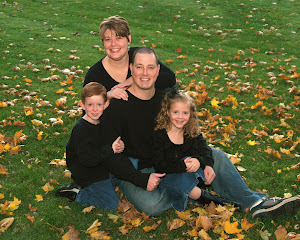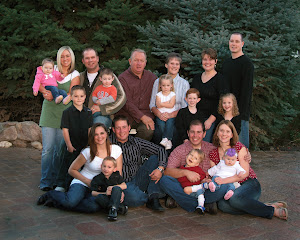I take the following from Jacqueline Haessly, from her book "Learning to Live Together." I couldn't say it any better so here is what she shares.
"I am fond of the motto, 'Conflict is neither right nor wrong. It just is.' Conflict exists because we are each uniquely different people with diverse likes, dislikes, strengths, weaknesses, needs, and life experiences. Conflicts frequently occur because of opposing needs, limited supplies or resources, or because of real or perceived value differences between us. Yet for most families, few areas trigger a more emotional response.
"If we experience conflict as a test of who is right and who is wrong, who will win and who will lose, we then experience conflict as threatening t ourselves. Here are some stepping stones to creative conflict resolution, using some of the ideas we've already talked about:
"Make people feel loved and affirmed, and they'll want to work together to resolve problems.
"Acknowledge that conflict exists; this is the first step to resolving it.
"Find win-win solutions. Too often conflicts are resolved by determining who is right (and, of course, who is wrong) by blaming and labeling. There are winners and losers, and the winner is often the person who is biggest, oldest, meanest, or the one who can hit the hardest, run the fastest, or stay silent the longest.
"Invite everyone in the family into the decision-making process in ways that allow them to express their ideas and feelings about a conflict honestly. Problem-solving and decision-making--key to good conflict resolution--can be nurtured from a very young age, by encouraging children to choose what to wear, how to spend part of a day or what the family should do after dinner.
"Help children consider the widest possible range of solutions to a problem, not just the 'right' solution. Even consider impossible solutions, so they can learn that sometimes the improbable can become possible.
"Help children understand which solutions are morally unacceptable because they are harmful to another person. Encouragement of violence toward a minority group in a neighborhood or school conflict is one example of unacceptable behavior.
"Give children practice with decision-making and problem-solving in non threatening situations."
Here are a few activities that may help teach problem-solving:
"Animal Sculptures"
Purpose: To encourage decision-making and problem-solving skills, even in very young children. To foster group work on a common project.
How it works: 1) Two people sit out to be "guessers." If more than five players, form two groups. Guessers work together to solve the puzzle. 2) Begin with the youngest player. Think of an animal and tell its name to the group without letting the "guessers" hear. The youngest person then arranges the members of the group to form the animal named. (Five players form on e elephant or dolphin, not five different elephants or dolphins.) 3) "Guessers" try to guess the animal. 4) Rotate so little and big people can take turns being decision-makers and group planners.
Variations: Do same for farm machinery, forms of transportation, small appliances.
"Search for Alternatives"
Purpose: To allow children to practice creative problem-solving in a simple, non-threatening setting.
How it works: Each person thinks of three ways to solve the following problems. Adults can help children understand the problem and identify possible solutions.
1) Toys are always left on the floor at bedtime.
2) One child is always late for dinner.
3) Dad or Mom is always late paying allowances.
4) Dirty laundry is often left lying on the floor.
5) Two people are having a conversation, one is watching TV, one is listening to the radio.
6) Uncle John, who is in a wheelchair, is coming to visit for a week. You want to make his visit pleasant and comfortable for all.
7) The family has decided that Mom and Dad must both work full time to save for a special family need: braces, medical expenses, a trip. What are three necessary changes?
8) Mom is going on a ten-day business trip. Dad and the children will be home alone.
Think of other applicable problems your family may have and write them down. You may consider these problems as possible conversation starters around the dinner table. Be careful, however, you would never want to sour dinner by having heated discussions on solving problems.
"Puppet Theater"
Purpose: To help children act out potential and real conflicts. Young children love puppets and can use them to take on words and behavior that they would otherwise find difficult to communicate.
How it works: 1) Make puppets from old socks or paper bags. Even young children can help to decorate with scraps of fabric or yarn. 2) Use puppets at times when battles emerge about household chores, play activities that exclude the youngest or oldest, sibling rivalries, and other recurring family struggles. Have children alternate roles.
"Instant Replay"
When a seemingly senseless conflict is getting out of hand because parent and child are over-reacting, the phrase "time-out and replay" lets both parties take a time out, then replay the scene. Both parties are then more open to hearing the other person's point of view. This usually leads to a mutually satisfying resolution of the conflict. Everyone's needs can be met, the task can be accomplished, and freedom of choice can be respected and preserved.
Patience
-
I had a friend express to me once what a patient person I was. I was blown
away. Did she not see me at the grocery while I grinned and bore a
screaming chi...
10 years ago














2 comments:
It is fun seeing you blog again Mom. I have missed it. Sure LOVE you!!! Thanks for all you do.
台湾辣妹视讯聊天室 , 台湾辣妹视讯聊天室 , 台湾辣妹视讯聊天室 , 台湾辣妹视讯聊天室 , 台湾辣妹视讯聊天室 , 台湾辣妹视讯聊天室 , 台湾辣妹视讯聊天室 , 台湾辣妹视讯聊天室 , 台湾辣妹视讯聊天室 , 台湾辣妹视讯聊天室
Post a Comment